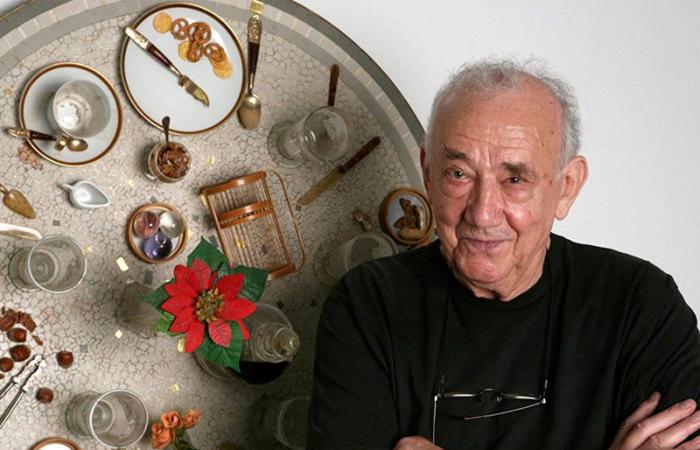Barely hours after the death of Louis Cane, another artist figure on the French scene in the 1960s and 1970s, Daniel Spoerri, famous for his Eat Art works, died on November 6 at the age of 94 years.
Born in 1930 in Galați in Romania, he grew up in Switzerland, where he was a principal dancer at the Berne Opera until 1957, then became a director, decorator and theater actor. It was there that he met Jean Tinguely as well as Fluxus artists such as Robert Filliou, Dieter Roth and Emmett Williams. He moved to Paris in 1959, in a small room at the Carcassonne hotel where he created his first works from objects found at flea markets. In 1960, he signed the New Realists manifesto, written by the art critic Pierre Restany and Yves Klein, alongside César, Jean Tinguely, Niki de Saint Phalle and Martial Raysse, among others.
The emblematic works of Daniel Spoerri are the “trap tables”tables containing the remains of meals that the artist places vertically on the wall, like a painting. They include the tablecloth, the cutlery and especially the remains of food, drinks as well as cigarette butts fixed on the table. The composition is left to chance, the artist’s only gesture being to move the table onto the wall.
Daniel Spoerri extends the concept of what he calls Eat Art to other types of creations. In 1963, he transformed Galerie J into a restaurant during the “723 kitchen utensils” exhibition. The artist invites art critics to serve the dishes he prepares, thus creating “trap tables” on the tables, fixed to the wall after the meal. A few years later, he opened the Spoerri Restaurant and the Eat Art Gallery in Düsseldorf, from 1968 to 1972. In addition to these collective works, the artist created objects such as stamped grocery products “work of art” and bread dough creations.
Influenced by the ready-made of Marcel Duchamp and the newspaper collages of Cubist paintings, Daniel Spoerri is part of the idea of a “poetic recycling of urban, industrial, advertising reality”. For him, objects are no longer represented but presented. “I didn’t want to make art, I wanted to show that even a table is like art”he explains in an interview. He creates “disabuse the eye” who ironize on the notion of trompe l’oeil in figurative painting. In 1961, he signed The Showera visual pun consisting of a landscape painting with a stream of water, on which he places an actual shower head.
Daniel Spoerri’s work is not limited to food, although this material is omnipresent in his work. It fixes various “object situations”such as boxes, consumer products and more organic objects (bones, skulls, dolls), presented during the exhibition at the Galerie Anne Barrault for its 90th anniversary in 2020. The art critic Pierre Restany talks about about his creations “complete still lifes of objective chance”. The still life is particularly marked in his late works, notably Body in piecesx (1991-1993), a wall composition made up of armor, prosthetics and masks, reminiscent of hunting and war trophies.
The artist benefited from a major retrospective at the Center Pompidou in 1990 and a monographic exhibition entitled “The theater of objects” at the MAMAC in Nice in 2021-2022. At the beginning of the 1990s, he set up a sculpture garden in Tuscany, which in 1997 became the Daniel Spoerri’s garden foundationwhere you can discover his sculptures alongside more than a hundred works by 55 other artists, spread over 16 hectares.
Il Giardino di Daniel Spoerri – Hic Terminus Haeret (The Garden of Daniel Spoerri – This frontier remains), in Seggiano in Tuscany.






